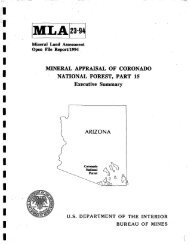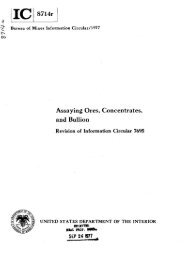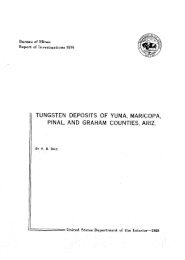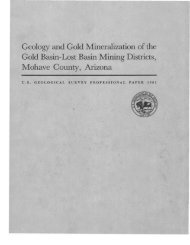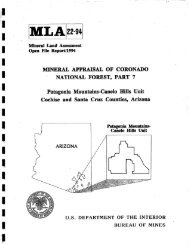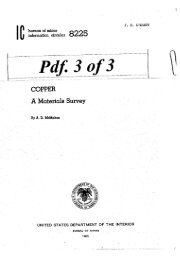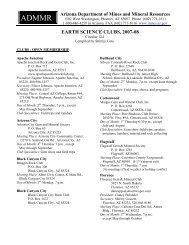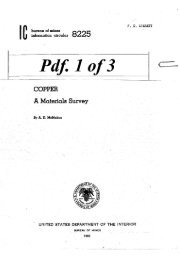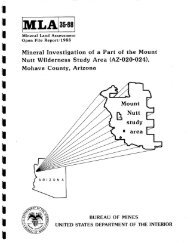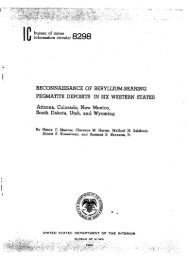here - State of Arizona Department of Mines and Mineral Resources
here - State of Arizona Department of Mines and Mineral Resources
here - State of Arizona Department of Mines and Mineral Resources
You also want an ePaper? Increase the reach of your titles
YUMPU automatically turns print PDFs into web optimized ePapers that Google loves.
68 PRINCIPAL GOLD-PRODUCING DISTRICTS OF THE UNITED STATES<br />
Gold production <strong>of</strong> Mariposa County for 1880<br />
1959 was about 2,144,500 ounces: about 583,500<br />
ounces came from placers <strong>and</strong> about 1,561,000<br />
ounces came from lodes. Production before 1880 has<br />
not been determined.<br />
Gold mining began at an early date in the county.<br />
Gravels along Agua Fria <strong>and</strong> Mariposa Creeks<br />
were worked before 1849 <strong>and</strong> were thoroughly<br />
mined out by the hordes <strong>of</strong> prospectors who overran<br />
the area during the gold rush <strong>of</strong> 1849. By July<br />
1849 a stamp mill was processing ore from the first<br />
lode discovery in the county, the Mariposa mine on<br />
the Mother Lode (Bowen <strong>and</strong> Gray, 1957, p. 39, 43).<br />
Lode mining in Mariposa County was inhibited<br />
by the controversial Las Mariposas l<strong>and</strong> grant<br />
which gave title to 14 <strong>of</strong> the 24 miles <strong>of</strong> the Mother<br />
Lode in the county to Gen. John C. Fremont. This<br />
grant was unsurveyed <strong>and</strong> was made before gold<br />
was discovered. Long before Fremont attempted to<br />
establish his right, the grant was overrun with<br />
prospectors <strong>and</strong> miners, who underst<strong>and</strong>ably were<br />
reluctant to give up what they considered just<br />
claims. Mter years <strong>of</strong> conflict in <strong>and</strong> out <strong>of</strong> the<br />
courts, Fremont's claim to the grant was formally<br />
recognized. But by then the property was plagued<br />
by mismanagement <strong>and</strong> inefficiency <strong>and</strong> the mines<br />
never fulfilled the expectations <strong>of</strong> the authorities<br />
who evaluated them (Julihn <strong>and</strong> Horton, 1940, p.<br />
95-96).<br />
Another large estate, the Cook estate, which encompassed<br />
most <strong>of</strong> the mines along a 2-mile length<br />
<strong>of</strong> the Mother Lode in the Coulterville area, further<br />
complicated operations on the Mother Lode in Mariposa<br />
County (Julihn <strong>and</strong> Horton, 1940, p. 96-97).<br />
Despite the early frustrations, lode mining in<br />
Mariposa County flourished <strong>and</strong> was especially successful<br />
in the late 1930's <strong>and</strong> early 1940's before<br />
most <strong>of</strong> the mines closed in compliance with War<br />
Production Board Order L-208 issued in October<br />
1942. After World War II gold mining declined,<br />
<strong>and</strong> during 1950-59 the average annual gold output<br />
was less than 1,000 ounces.<br />
The western two-thirds <strong>of</strong> the county is underlain<br />
by metasedimentary rocks <strong>and</strong> metavolcanics<br />
<strong>of</strong> Paleozoic <strong>and</strong> Late Jurassic age, <strong>and</strong> the eastern<br />
one-third is underlain chiefly by intrusives <strong>of</strong> Late<br />
Jurassic or Early Cretaceous age (Bowen <strong>and</strong> Gray,<br />
1957, p. 45). The intrusive rocks consist <strong>of</strong> various<br />
types <strong>of</strong> granitic <strong>and</strong> peridotitic rocks, but biotitehornblende<br />
granodiorite is predominant.<br />
HORNITOS DISTRICT<br />
The Hornitos district, in western Mariposa<br />
County at lat 37°30' N. <strong>and</strong> long 120°14' W., is<br />
noted for gold production from both plac"rs <strong>and</strong><br />
lodes.<br />
In the early days the Quaternary grr.vels <strong>of</strong><br />
Hornitos Creek yielded considerable gold, b'1t these<br />
were nearly exhausted before 1900. The lode mines<br />
are all west <strong>of</strong> the Mother Lode, in the zone <strong>of</strong> veins<br />
referred to as the West Belt. Total production from<br />
the district is not known, but a minimum <strong>of</strong> 500,000<br />
ounces seems to be a reasonable estimate.<br />
The gold deposits <strong>of</strong> the West Belt are in veins<br />
that cut several rock types, chiefly metasedimentary<br />
rocks <strong>of</strong> the Mariposa Formation <strong>of</strong> Jurar"lic age.<br />
The Mariposa is intruded locally by serpentinized<br />
peridotite, pyroxenite, basic intrusives altered to<br />
hornblende schists, <strong>and</strong> acid intrusives such as<br />
granite <strong>and</strong> granodiorite (Julihn <strong>and</strong> Hort(J"l, 1940,<br />
p. 116-117). Most <strong>of</strong> the gold deposits al'';! along<br />
contacts <strong>of</strong> igneous rocks <strong>and</strong> metasedimentary<br />
rocks.<br />
MERCED RIVER PLACERS<br />
Quaternary gravels along the Merced River west<br />
<strong>of</strong> Bagby were a source <strong>of</strong> placer gold in the late<br />
1860's <strong>and</strong> 1870's (Bowen <strong>and</strong> Gray, 1957, p. 187),<br />
but little activity has been reported in recert years.<br />
Production from these deposits is not known, but<br />
probably was at least 50,000 ounces <strong>of</strong> gold.<br />
MORMON BA.R DISTRICT<br />
The Mormon Bar district is in T. 5 S., r.. 18 E.,<br />
about 2lh miles south <strong>of</strong> the town <strong>of</strong> Mariposa.<br />
In the early days <strong>of</strong> mining in Mariposa County,<br />
the headwaters <strong>of</strong> Mariposa Creek near Mormon<br />
Bar was the scene <strong>of</strong> considerable placer activity.<br />
By 1870, however, the deposits, which were only<br />
about 6 feet thick, were almost worked out, <strong>and</strong><br />
t<strong>here</strong>after the placer output <strong>of</strong> the entire county<br />
averaged only a few hundred ounces p"r year<br />
(Julihn <strong>and</strong> Horton, 1940, p. 159, 162). In the late<br />
1930's a slight revival took place, <strong>and</strong> the gravels<br />
at Mormon Bar were worked industriously by dragline<br />
(Julihn <strong>and</strong> Horton, 1940, p. 159). Total gold<br />
production for the district is estimated r.t about<br />
75,000 ounces.<br />
MOTHER LODE A.ND EAST BELT DISTRI0TS<br />
The Mother Lode, which has its southen terminus<br />
in Mariposa County, is a northwest-t.rending<br />
zone that is 3 or 4 miles wide <strong>and</strong> extends from the<br />
town <strong>of</strong> Mormon Bar northward through Coulterville<br />
into Tuolumne County. Roughly parallel veins<br />
east <strong>of</strong> this zone are referred to as the East. Belt.<br />
Though much has been said about the pr....duction<br />
<strong>of</strong> the Mother Lode, the mines <strong>of</strong> the East Belt <strong>and</strong>



